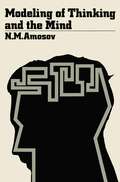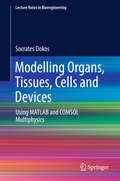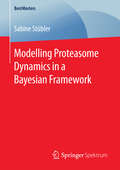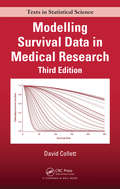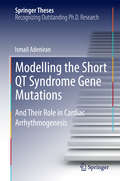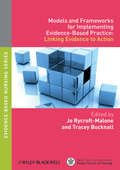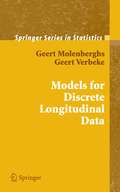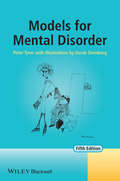- Table View
- List View
Modelling of Environmental Chemical Exposure and Risk (NATO Science Series: IV: #2)
by Jan B. H. J. LindersMathematical models are being increasingly used to estimate the concentrations of a wide range of substances in the environment for a variety of reasons, including government control and legislation, and risk and hazard estimation. Exposure assessment has to be performed for many types of substances, including pesticides, industrial chemicals, pollutants, accidental discharges, etc. The interpretation of the results of model equations should always bear in mind the purpose for which the model used was built in the first place. Further, models are always an abstraction of reality, requiring simplifying assumptions to keep the models within the restraints posed by computer performance and/or scientific knowledge. The present book treats the theme of modelling chemical exposure and risk in terms of four main topics: model characteristics, applications, comparison of estimated with measured concentrations, and modelling credibility.
Modelling of GPCRs: A Practical Handbook
by Andrea Strasser Hans-Joachim WittmannG protein coupled receptors (GPCRs) comprise an important protein family, which is involved in signal transduction in the cell. Besides that a large number of drugs, available on market, address GPCRs. For an efficient and improved development of appropriate drugs, molecular modelling of GPCRs is – in order to understand the ligand-receptor interactions and functionality of GPCRs on molecular level - an important tool. The book “Modelling of GPCRs – a practical handbook” is focussed onto a practical introduction into molecular modelling of GPCRs. This book is very useful for beginners in GPCR modelling, but also addresses the advanced GPCR modeller: On the one hand, the book introduces principles of GPCR modelling, including extensive examples. On the other hand, detailed outlooks onto advanced GPCR modelling techniques are presented. Furthermore, the book includes important data, like information about crystal structures in a summarized manner or amino acid sequences, which are essential for GPCR modelling in general. Due to an increase in efficacy and data handling most modellers use LINUX as operating system. To address this, a summary of most important LINUX commands with examples is presented within the book.
Modelling Organs, Tissues, Cells and Devices: Using MATLAB and COMSOL Multiphysics (Lecture Notes in Bioengineering)
by Socrates DokosThis book presents a theoretical and practical overview of computational modeling in bioengineering, focusing on a range of applications including electrical stimulation of neural and cardiac tissue, implantable drug delivery, cancer therapy, biomechanics, cardiovascular dynamics, as well as fluid-structure interaction for modelling of organs, tissues, cells and devices. It covers the basic principles of modeling and simulation with ordinary and partial differential equations using MATLAB and COMSOL Multiphysics numerical software. The target audience primarily comprises postgraduate students and researchers, but the book may also be beneficial for practitioners in the medical device industry.
Modelling Parasite Transmission and Control (Advances in Experimental Medicine and Biology #673)
by Edwin Michael Robert C. SpearIt is clear that many fascinating problems still remain to be addressed in parasite transmission modelling, from better understanding of transmission processes and natural history of infection to investigating the impact of ecological and spatial scales, climate change, host immunity and social behaviour, parasite-host evolutionary dynamics and parasite community ecology on parasite transmission. This book captures some of the advances made in recent years and provides indications of ways forward for addressing these questions by shedding light on developments in conceptual frameworks and modelling tools as well as the emergence of new data forms for aiding model construction, testing and analysis. Another important advance has been the parallel development of robust computationally-intensive statistical methods to allow model testing and parameterization by aiding the fitting of models to complex data. This is an exciting area of work, which we believe will broaden the scope of mathematical modelling in investigating parasite transmission processes. In particular, we expect this advance will now allow modellers to begin the successful development and analysis of mechanistically-rich models of parasite transmission that will facilitate better integration of the variety of mechanisms increasingly recognized as important in simultaneously affecting transmission, including abiotic processes, trophic and evolutionary interactions, movement in space, and behaviour and even physiology of the individual. We foresee a continuing bright future for using mathematical modelling to clarify parasite transmission dynamics and address problems related to effective parasite control. Ultimately, through this improved application of models to research and management, we expect that parasite control would be an achievable goal bringing benefits to a vast number of our fellow human beings.
Modelling Population Dynamics: Model Formulation, Fitting and Assessment using State-Space Methods (Methods in Statistical Ecology)
by K. B. Newman S. T. Buckland B. J. Morgan R. King D. L. Borchers D. J. Cole P. Besbeas O. Gimenez L. ThomasThis book gives a unifying framework for estimating the abundance of open populations: populations subject to births, deaths and movement, given imperfect measurements or samples of the populations. The focus is primarily on populations of vertebrates for which dynamics are typically modelled within the framework of an annual cycle, and for which stochastic variability in the demographic processes is usually modest. Discrete-time models are developed in which animals can be assigned to discrete states such as age class, gender, maturity, population (within a metapopulation), or species (for multi-species models).The book goes well beyond estimation of abundance, allowing inference on underlying population processes such as birth or recruitment, survival and movement. This requires the formulation and fitting of population dynamics models. The resulting fitted models yield both estimates of abundance and estimates of parameters characterizing the underlying processes.
Modelling Potential Malaria Spread in Germany by Use of Climate Change Projections: A Risk Assessment Approach Coupling Epidemiologic and Geostatistical Measures (SpringerBriefs in Environmental Science)
by Winfried Schröder Gunther SchmidtThis book investigates the spatial distribution of potential temperature-driven malaria transmissions, using the basic reproduction rate (R0) to model the reproduction of the malaria pathogen Plasmodium vivax. The authors mapped areas at risk of an outbreak of tertian malaria in the federal state of Lower Saxony (pre-study) and for whole Germany (main-study) by means of geostatistics for past (1947-2007) and future periods. Projections based on predicted monthly mean air temperature data derived from the IPCC and regionally discriminated by two regional climate models (REMO, WettReg) for the countrywide study.
Modelling Proteasome Dynamics in a Bayesian Framework (BestMasters)
by Sabine StüblerSabine Stübler compares different proteasome isoforms and subtypes in terms of their transport and active site-related parameters applying an existing computational model. In a second step, the author extends this model to be able to describe the influence of proteasome inhibitors in in vitro experiments. The computational model, which describes the hydrolysis of short fluorogenic peptides by the 20S proteasome, is calibrated to experimental data from different proteasome isoforms using an approximate Bayesian computation approach. The dynamics of proteasome inhibitors are included into the model in order to demonstrate how to modulate the inhibitor’s transport parameters for strong or isoform-specific inhibition.
Modelling Radiotherapy Side Effects: Practical Applications for Planning Optimisation (Series in Medical Physics and Biomedical Engineering)
by Tiziana Rancati Claudio FiorinoThe treatment of a patient with radiation therapy is planned to find the optimal way to treat a tumour while minimizing the dose received by the surrounding normal tissues. In order to better exploit the possibilities of this process, the availability of accurate and quantitative knowledge of the peculiar responses of the different tissues is of paramount importance. This book provides an invaluable tutorial for radiation oncologists, medical physicists, and dosimetrists involved in the planning optimization phase of treatment. It presents a practical, accessible, and comprehensive summary of the field’s current research and knowledge regarding the response of normal tissues to radiation. This is the first comprehensive attempt to do so since the publication of the QUANTEC guidelines in 2010. Features: Addresses the lack of systemization in the field, providing educational materials on predictive models, including methods, tools, and the evaluation of uncertainties Collects the combined effects of features, other than dose, in predicting the risk of toxicity in radiation therapy Edited by two leading experts in the field
Modelling Radiotherapy Side Effects: Practical Applications for Planning Optimisation (Series in Medical Physics and Biomedical Engineering)
by Tiziana Rancati Claudio FiorinoThe treatment of a patient with radiation therapy is planned to find the optimal way to treat a tumour while minimizing the dose received by the surrounding normal tissues. In order to better exploit the possibilities of this process, the availability of accurate and quantitative knowledge of the peculiar responses of the different tissues is of paramount importance. This book provides an invaluable tutorial for radiation oncologists, medical physicists, and dosimetrists involved in the planning optimization phase of treatment. It presents a practical, accessible, and comprehensive summary of the field’s current research and knowledge regarding the response of normal tissues to radiation. This is the first comprehensive attempt to do so since the publication of the QUANTEC guidelines in 2010. Features: Addresses the lack of systemization in the field, providing educational materials on predictive models, including methods, tools, and the evaluation of uncertainties Collects the combined effects of features, other than dose, in predicting the risk of toxicity in radiation therapy Edited by two leading experts in the field
Modelling Survival Data in Medical Research (Chapman And Hall/crc Texts In Statistical Science Ser.)
by David CollettModelling Survival Data in Medical Research describes the modelling approach to the analysis of survival data using a wide range of examples from biomedical research.Well known for its nontechnical style, this third edition contains new chapters on frailty models and their applications, competing risks, non-proportional hazards, and dependent censo
Modelling Survival Data in Medical Research (Chapman & Hall/CRC Texts in Statistical Science)
by David CollettModelling Survival Data in Medical Research, Fourth Edition, describes the analysis of survival data, illustrated using a wide range of examples from biomedical research. Written in a non-technical style, it concentrates on how the techniques are used in practice. Starting with standard methods for summarising survival data, Cox regression and parametric modelling, the book covers many more advanced techniques, including interval-censoring, frailty modelling, competing risks, analysis of multiple events, and dependent censoring. This new edition contains chapters on Bayesian survival analysis and use of the R software. Earlier chapters have been extensively revised and expanded to add new material on several topics. These include methods for assessing the predictive ability of a model, joint models for longitudinal and survival data, and modern methods for the analysis of interval-censored survival data. Features: Presents an accessible account of a wide range of statistical methods for analysing survival data Contains practical guidance on modelling survival data from the author’s many years of experience in teaching and consultancy Shows how Bayesian methods can be used to analyse survival data Includes details on how R can be used to carry out all the methods described, with guidance on the interpretation of the resulting output Contains many real data examples and additional data sets that can be used for coursework All data sets used are available in electronic format from the publisher’s website Modelling Survival Data in Medical Research, Fourth Edition, is an invaluable resource for statisticians in the pharmaceutical industry and biomedical research centres, research scientists and clinicians who are analysing their own data, and students following undergraduate or postgraduate courses in survival analysis.
Modelling Survival Data in Medical Research (Chapman & Hall/CRC Texts in Statistical Science)
by David CollettModelling Survival Data in Medical Research, Fourth Edition, describes the analysis of survival data, illustrated using a wide range of examples from biomedical research. Written in a non-technical style, it concentrates on how the techniques are used in practice. Starting with standard methods for summarising survival data, Cox regression and parametric modelling, the book covers many more advanced techniques, including interval-censoring, frailty modelling, competing risks, analysis of multiple events, and dependent censoring. This new edition contains chapters on Bayesian survival analysis and use of the R software. Earlier chapters have been extensively revised and expanded to add new material on several topics. These include methods for assessing the predictive ability of a model, joint models for longitudinal and survival data, and modern methods for the analysis of interval-censored survival data. Features: Presents an accessible account of a wide range of statistical methods for analysing survival data Contains practical guidance on modelling survival data from the author’s many years of experience in teaching and consultancy Shows how Bayesian methods can be used to analyse survival data Includes details on how R can be used to carry out all the methods described, with guidance on the interpretation of the resulting output Contains many real data examples and additional data sets that can be used for coursework All data sets used are available in electronic format from the publisher’s website Modelling Survival Data in Medical Research, Fourth Edition, is an invaluable resource for statisticians in the pharmaceutical industry and biomedical research centres, research scientists and clinicians who are analysing their own data, and students following undergraduate or postgraduate courses in survival analysis.
Modelling the Short QT Syndrome Gene Mutations: And Their Role in Cardiac Arrhythmogenesis (Springer Theses)
by Ismail AdeniranThe Short QT Syndrome (SQTS) is characterized by abbreviated QT intervals on the electrocardiogram, increased risk of cardiac arrhythmias and sudden death. Although several gene mutations have been identified in SQT patients, the role of these mutations in promoting arrhythmogenesis is still not completely understood. Consequently, this thesis employs multidisciplinary approaches to develop a 3D virtual heart, which is then used to elucidate how the short QT syndrome facilitates and maintains ventricular arrhythmias and to determine its effects on ventricular mechanical contraction. The findings in this thesis provide a comprehensive and mechanistic explanation for a number of gene mutations associated with potassium channels in terms of susceptibility to arrhythmia. The multiphysics models developed provide a powerful platform for identifying the root causes of various arrhythmias and investigating therapeutic interventions for these diseases.The thesis was examined by Prof. Chris Huang of the University of Cambridge, the most authoritative figure in cardiac electrophysiology, who has described the work as “outstanding.”
Modelling the Toxicity of Nanoparticles (Advances in Experimental Medicine and Biology #947)
by Lang Tran, Miguel A. Bañares and Robert RalloIn today’s nanotechnology and pharmaceutical research, alternative toxicology testing methods are crucial for ethically and commercially sound practice. This book provides practical guidelines on how to develop and validate quantitative nanostructure-toxicity relationship (QNTR) models, which are ideal for rapidly exploring the effects of a large number of variables in complex scenarios. Through contributions by academic, industrial, and governmental experts, Modelling the Toxicity of Nanoparticles delivers clear instruction on these methods and their integration and use in risk assessment. Specific topics include the physico-chemical characteristics of engineered nanoparticles, nanoparticle interactions, in vivo nanoparticle processing, and more. A much-needed practical guide, Modelling the Toxicity of Nanoparticles is a key text for researchers as well as government and industry regulators.
Modelling Tropospheric Volcanic Aerosol: From Aerosol Microphysical Processes to Earth System Impacts (Springer Theses)
by Anja SchmidtAnja Schmidt's thesis is a unique and comprehensive evaluation of the impacts of tropospheric volcanic aerosol on the atmosphere, climate, air quality and human health. Using a state-of-the-art global microphysics model, the thesis describes and quantifies the impact of volcanic sulphur emissions on global aerosol, clouds and the radiative forcing of climate. The advanced model enables the first ever estimate of the impact of the emissions on aerosol microphysical properties such as particle number concentrations and sizes, and therefore a considerably improved ability to quantify the climate and air quality effects. There are several important discoveries in this thesis. Firstly, it is shown that continuously degassing volcanoes exert a major effect on global clouds and climate. Secondly, the impact of the 1783 Laki eruption in Iceland is re-examined to show that this long-lasting flood lava eruption would have had major effects on clouds and climate. Thirdly, by combining her research on volcanism, atmospheric science and epidemiology, she shows that a present-day Laki-like eruption would seriously affect European air quality and cause over 100000 premature deaths in the first year.
Models and Frameworks for Implementing Evidence-Based Practice: Linking Evidence to Action (Evidence Based Nursing #2)
by Jo Rycroft-Malone Tracey BucknallThe Evidence-Based Nursing Series is co-published with Sigma Theta Tau International (STTI). The series focuses on implementing evidence-based practice in nursing and mirrors the remit of Worldviews on Evidence-Based Nursing, encompassing clinical practice, administration, research and public policy. Models and Frameworks for Implementing Evidence- Based Practice: Linking Evidence to Action looks at ways of implementing evidence gained through research and factors that influence successful implementation. It acknowledges the gap that exists between obtaining evidence and the practicalities of putting it into practice and provides direction to help to close this gap. This, the first book in the series, helps the reader to make decisions about the appropriateness of using various models and frameworks. A selection of models and frameworks are examined in detail including examples of their use in practice. The book concludes with an analysis and synthesis of the included models and frameworks. The models and frameworks that have been included are based on a number of criteria: that they are internationally recognised, have undergone widespread evaluation and testing, are transferable across different settings, and can be used by different disciplines. Models and frameworks include: Stetler Model Ottowa Model of Research Use IOWA model of evidence-based practice Advancing Research and Clinical Practice through Close Collaboration (ARCC) model Dobbins’ dissemination and use of research evidence for policy and practice framework Joanna Briggs Institute model Knowledge to Action framework Promoting Action on Research Implementation in Health Services (PARIHS) Key Points: Includes an overview of implementation issues and the use of theory and frameworks in implementing evidence into practice Chapters are written by the developers of the model or framework Each chapter provides background on an implementation model or framework, suitable applications, underlying theory and examples of use Each chapter examines strengths and weaknesses of each model alongside barriers and facilitators for its implementation
Models and Frameworks for Implementing Evidence-Based Practice: Linking Evidence to Action (Evidence Based Nursing)
by Jo Rycroft-Malone Tracey BucknallThe Evidence-Based Nursing Series is co-published with Sigma Theta Tau International (STTI). The series focuses on implementing evidence-based practice in nursing and mirrors the remit of Worldviews on Evidence-Based Nursing, encompassing clinical practice, administration, research and public policy. Models and Frameworks for Implementing Evidence- Based Practice: Linking Evidence to Action looks at ways of implementing evidence gained through research and factors that influence successful implementation. It acknowledges the gap that exists between obtaining evidence and the practicalities of putting it into practice and provides direction to help to close this gap. This, the first book in the series, helps the reader to make decisions about the appropriateness of using various models and frameworks. A selection of models and frameworks are examined in detail including examples of their use in practice. The book concludes with an analysis and synthesis of the included models and frameworks. The models and frameworks that have been included are based on a number of criteria: that they are internationally recognised, have undergone widespread evaluation and testing, are transferable across different settings, and can be used by different disciplines. Models and frameworks include: Stetler Model Ottowa Model of Research Use IOWA model of evidence-based practice Advancing Research and Clinical Practice through Close Collaboration (ARCC) model Dobbins’ dissemination and use of research evidence for policy and practice framework Joanna Briggs Institute model Knowledge to Action framework Promoting Action on Research Implementation in Health Services (PARIHS) Key Points: Includes an overview of implementation issues and the use of theory and frameworks in implementing evidence into practice Chapters are written by the developers of the model or framework Each chapter provides background on an implementation model or framework, suitable applications, underlying theory and examples of use Each chapter examines strengths and weaknesses of each model alongside barriers and facilitators for its implementation
Models and Techniques in Stroke Biology
by Amit Kumar Tripathi Abhishek Kumar SinghThis book summarizes various tools and techniques used to provide insights into the cellular and molecular pathophysiology of stroke. It also presents rodent animal models to help shed light on the pathophysiology of ischemic stroke. Presenting the latest information on the different types of stroke, including embolic, filament, photothrombotic, and bilateral common carotid artery, the book also describes techniques that are used for confirmation of stroke surgery, such as laser speckle imaging (LSI) and laser Doppler flowmetry (LDF), and discusses the non-human primates that are used in stroke surgery, cerebral venous sinuous thrombosis, and neurobehavioral assessment. Lastly, it analyzes various neuroprotective agents to treat and prevent ischemic stroke, and examines the challenges and advances in treating and preventing acute ischemic stroke.
Models for Assessing Drug Absorption and Metabolism (Pharmaceutical Biotechnology #8)
by Ronald T. Borchardt Philip L. Smith Glynn WilsonPharmaceutical scientists in industry and academia will appreciate this single reference for its detailed experimental procedures for conducting biopharmaceutical studies. This well-illustrated guide allows them to establish, validate, and implement commonly used in situ and in vitro model systems. Chapters provide ready access to these methodologies for studies of the intestinal, buccal, nasal and respiratory, vaginal, ocular, and dermal epithelium as well as the endothelial and elimination barriers.
Models for Delivering High Quality Emergency Neurosurgery in High Income Countries (Elements in Emergency Neurosurgery)
by null Matthew A. Boissaud-Cooke null Marike Broekman null Jeroen van Dijck null Marco Lee null Paul GrundyEmergency neurosurgery encompasses serious and high-risk cranial and spinal conditions across all ages. The authors provide an overview of the changes occurring within emergency surgery to meet the challenges provided from unscheduled care. Considering the wider landscape of emergency surgery provides a context for the changes occurring within emergency neurosurgery. The delivery of emergency neurosurgery within the UK, the Republic of Ireland, the Netherlands, and the United States of America (USA) is then described to provide an overview of different models of care.
Models for Discrete Longitudinal Data (Springer Series in Statistics)
by Geert Molenberghs Geert VerbekeThe linear mixed model has become the main parametric tool for the analysis of continuous longitudinal data, as the authors discussed in their 2000 book. Without putting too much emphasis on software, the book shows how the different approaches can be implemented within the SAS software package. The authors received the American Statistical Association's Excellence in Continuing Education Award based on short courses on longitudinal and incomplete data at the Joint Statistical Meetings of 2002 and 2004.
Models for Intensive Longitudinal Data
by Joseph L. Schafer Theodore A. WallsRapid technological advances in devices used for data collection have led to the emergence of a new class of longitudinal data: intensive longitudinal data (ILD). Behavioral scientific studies now frequently utilize handheld computers, beepers, web interfaces, and other technological tools for collecting many more data points over time than previously possible. Other protocols, such as those used in fMRI and monitoring of public safety, also produce ILD, hence the statistical models in this volume are applicable to a range of data. The volume features state-of-the-art statistical modeling strategies developed by leading statisticians and methodologists working on ILD in conjunction with behavioral scientists. Chapters present applications from across the behavioral and health sciences, including coverage of substantive topics such as stress, smoking cessation, alcohol use, traffic patterns, educational performance and intimacy. Models for Intensive Longitudinal Data (MILD) is designed for those who want to learn about advanced statistical models for intensive longitudinal data and for those with an interest in selecting and applying a given model. The chapters highlight issues of general concern in modeling these kinds of data, such as a focus on regulatory systems, issues of curve registration, variable frequency and spacing of measurements, complex multivariate patterns of change, and multiple independent series. The extraordinary breadth of coverage makes this an indispensable reference for principal investigators designing new studies that will introduce ILD, applied statisticians working on related models, and methodologists, graduate students, and applied analysts working in a range of fields. A companion Web site at www.oup.com/us/MILD contains program examples and documentation.
Models for Intensive Longitudinal Data
by Theodore A.Walls and Joseph L. SchaferRapid technological advances in devices used for data collection have led to the emergence of a new class of longitudinal data: intensive longitudinal data (ILD). Behavioral scientific studies now frequently utilize handheld computers, beepers, web interfaces, and other technological tools for collecting many more data points over time than previously possible. Other protocols, such as those used in fMRI and monitoring of public safety, also produce ILD, hence the statistical models in this volume are applicable to a range of data. The volume features state-of-the-art statistical modeling strategies developed by leading statisticians and methodologists working on ILD in conjunction with behavioral scientists. Chapters present applications from across the behavioral and health sciences, including coverage of substantive topics such as stress, smoking cessation, alcohol use, traffic patterns, educational performance and intimacy. Models for Intensive Longitudinal Data (MILD) is designed for those who want to learn about advanced statistical models for intensive longitudinal data and for those with an interest in selecting and applying a given model. The chapters highlight issues of general concern in modeling these kinds of data, such as a focus on regulatory systems, issues of curve registration, variable frequency and spacing of measurements, complex multivariate patterns of change, and multiple independent series. The extraordinary breadth of coverage makes this an indispensable reference for principal investigators designing new studies that will introduce ILD, applied statisticians working on related models, and methodologists, graduate students, and applied analysts working in a range of fields. A companion Web site at www.oup.com/us/MILD contains program examples and documentation.
Models for Mental Disorder: Conceptual Models In Psychiatry
by Peter TyrerModels for Mental Disorder, first published in 1987, anticipated the move towards integration of psychiatric services into multidisciplinary teams (doctor, psychologist, nurse, social worker, etc) and the need to bring together the different philosophies of mental illness. Peter Tyrer has identified four different models of mental disorder that are relevant to clinical practice: the disease, psychodynamic, cognitive-behavioural and social models. Each model is described and reviewed, with reference to case studies and illustrations, to show how it relates to mental health disorders and can be used to interpret and manage these disorders. The book has been widely read and is often used for training purposes so that each professional can understand and appreciate that differences in viewpoint are often a consequence of one or more models being used in a different way rather than a fundamental schism in approach. Since the fourth edition was published in 2005, the disciplines of mental health have moved even closer together with the growth of assertive outreach and more integrated community teams. This, combined with the greater awareness of mental health among users of services, which leads to more penetrating and informed questions at interviews with professionals, has emphasized the need for a wider understanding of these models. • The only book to describe the models framing mental health diagnosis and management • A great review for those wanting a better grasp of psychiatric disorders and for integration of concepts for treatment planning • New information on formal classifi cations of mental disorder • New information on mindfulness and mentalization regarding the dynamic model • Clearly written in a style which includes some humour and a conversational presentation – a joy to read for the beginner and more experienced practitioner alike • Features a teaching exercise for use when training students in the various models


